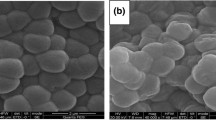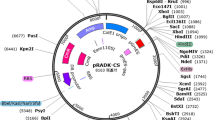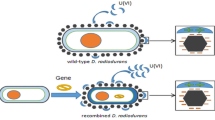Abstract
Deinococcus radiodurans is a bacterium being investigated for mechanisms of extreme radiation resistance and for bioremediation of environmental radioactive waste sites. In both fundamental and applied research settings, methods for large-scale production of D. radiodurans are needed. In this study, a systematic investigation was carried out to optimize D. radiodurans production at the 20-L fermentor scale. In defined medium, the phosphate buffer typically used was found to be inhibitory to D. radiodurans growth, and caused cell aggregation. Substitution of HEPES and MOPS buffers for phosphate buffer improved D. radiodurans growth characteristics. Several antifoaming agents were investigated to support large-scale production with submerged aeration, and the defoamer KFO 673 was chosen based on its ability to prevent foaming without affecting D. radiodurans growth. The conventional undefined rich medium tryptone/glucose/yeast extract (TGY) maximally supported D. radiodurans growth to an OD600 of 10. Using a ‘design of experiments’ approach, we found glucose, Mg and Mn to be critical in supporting high-density growth of D. radiodurans. The optimal pH and temperature for D. radiodurans growth in large-scale preparations were 7.0 and 37°C, respectively. Growth was carried out in a 20-L fermentor using the newly developed media under the optimal conditions. With addition of 10 g/L glucose, 0.5 g/L MgSO4 · 7H2O, 5 µM MnCl2 into TGY media, an OD600 of 40 was achieved.







Similar content being viewed by others
References
Anderson AW, Nordan HC, Cain RF, Parrish G, Duggan D (1956) Studies on a radio-resistant micrococcus. I. Isolation, morphology, cultural characteristics, and resistance to gamma radiation. Food Technol 10:575–578
Appukuttan D, Rao AS, Apte SK (2006) Engineering of Deinococcus radiodurans R1 for bioprecipitation of uranium from dilute nuclear waste. Appl Environ Microbiol 72:7873–7878. doi:10.1128/AEM.01362-06
Bdel-Fattah YR, El EH, Anwar M, Omar H, Abolmagd E, Abou ZR (2007) Application of factorial experimental designs for optimization of cyclosporin A production by Tolypocladium inflatum in submerged culture. J Microbiol Biotechnol 17:1930–1936
Brim H, McFarlan SC, Fredrickson JK, Minton KW, Zhai M, Wackett LP, Daly MJ (2000) Engineering Deinococcus radiodurans for metal remediation in radioactive mixed waste environments. Nat Biotechnol 18:85–90. doi:10.1038/71986
Brim H, Osborne JP, Kostandarithes HM, Fredrickson JK, Wackett LP, Daly MJ (2006) Deinococcus radiodurans engineered for complete toluene degradation facilitates Cr(VI) reduction. Microbiology 152:2469–2477. doi:10.1099/mic.0.29009-0
Brim H, Venkateswaran A, Kostandarithes HM, Fredrickson JK, Daly MJ (2003) Engineering Deinococcus geothermalis for bioremediation of high-temperature radioactive waste environments. Appl Environ Microbiol 69:4575–4582. doi:10.1128/AEM.69.8.4575-4582.2003
Cox MM, Battista JR (2005) Deinococcus radiodurans—the consummate survivor. Nat Rev Microbiol 3:882–892. doi:10.1038/nrmicro1264
Daly MJ (2000) Engineering radiation-resistant bacteria for environmental biotechnology. Curr Opin Biotechnol 11:280–285. doi:10.1016/S0958-1669(00)00096-3
Daly MJ, Gaidamakova EK, Matrosova VY, Vasilenko A, Zhai M, Leapman RD, Lai B, Ravel B, Li SM, Kemner KM, Fredrickson JK (2007) Protein oxidation implicated as the primary determinant of bacterial radioresistance. PLoS Biol 5:e92. doi:10.1371/journal.pbio.0050092
Daly MJ, Ouyang L, Fuchs P, Minton KW (1994) In vivo damage and recA-dependent repair of plasmid and chromosomal DNA in the radiation-resistant bacterium Deinococcus radiodurans. J Bacteriol 176:3508–3517
Fredrickson JK, Kostandarithes HM, Li SW, Plymale AE, Daly MJ (2000) Reduction of Fe(III), Cr(VI), U(VI), and Tc(VII) by Deinococcus radiodurans R1. Appl Environ Microbiol 66:2006–2011. doi:10.1128/AEM.66.5.2006-2011.2000
Holland AD, Rothfuss HM, Lidstrom ME (2006) Development of a defined medium supporting rapid growth for Deinococcus radiodurans and analysis of metabolic capacities. Appl Microbiol Biotechnol 72:1074–1082. doi:10.1007/s00253-006-0399-1
Iyer P, Singhal RS (2007) Production of glutaminase (E.C.3.2.1.5) from Zygosaccharomyces rouxii: Statistical optimization using response surface methodology. Bioresour Technol
Lange CC, Wackett LP, Minton KW, Daly MJ (1998) Engineering a recombinant Deinococcus radiodurans for organopollutant degradation in radioactive mixed waste environments. Nat Biotechnol 16:929–933. doi:10.1038/nbt1098-929
Makarova KS, Aravind L, Wolf YI, Tatusov RL, Minton KW, Koonin EV, Daly MJ (2001) Genome of the extremely radiation-resistant bacterium Deinococcus radiodurans viewed from the perspective of comparative genomics. Microbiol Mol Biol Rev 65:44–79. doi:10.1128/MMBR.65.1.44-79.2001
Makarova KS, Omelchenko MV, Gaidamakova EK, Matrosova VY, Vasilenko A, Zhai M, Lapidus A, Copeland A, Kim E, Land M, Mavrommatis K, Pitluck S, Richardson PM, Detter C, Brettin T, Saunders E, Lai B, Ravel B, Kemner KM, Wolf YI, Sorokin A, Gerasimova AV, Gelfand MS, Fredrickson JK, Koonin EV, Daly MJ (2007) Deinococcus geothermalis: The pool of extreme radiation resistance genes shrinks. PLoS ONE 2:e955. doi:10.1371/journal.pone.0000955
Masurekar PS (2008) Nutritional and engineering aspects of microbial process development. Prog Drug Res 65:291, 293–291, 328
Raj HD, Duryee FL, Deeney AM, Wang CH, Anderson AW, Elliker PR (1960) Utilization of carbohydrates and amino acids by Micrococcus radiodurans. Can J Microbiol 6:289–298
Shapiro A, DiLello D, Loudis MC, Keller DE, Hutner SH (1977) Minimal requirements in defined media for improved growth of some radio-resistant pink tetracocci. Appl Environ Microbiol 33:1129–1133
Venkateswaran A, McFarlan SC, Ghosal D, Minton KW, Vasilenko A, Makarova K, Wackett LP, Daly MJ (2000) Physiologic determinants of radiation resistance in Deinococcus radiodurans. Appl Environ Microbiol 66:2620–2626. doi:10.1128/AEM.66.6.2620-2626.2000
Acknowledgments
This research was supported by the Intramural Research Program of the National Heart, Lung, and Blood Institute, National Institutes of Health.
Author information
Authors and Affiliations
Corresponding author
Rights and permissions
About this article
Cite this article
He, Y. High cell density production of Deinococcus radiodurans under optimized conditions. J Ind Microbiol Biotechnol 36, 539–546 (2009). https://doi.org/10.1007/s10295-008-0524-5
Received:
Accepted:
Published:
Issue Date:
DOI: https://doi.org/10.1007/s10295-008-0524-5




